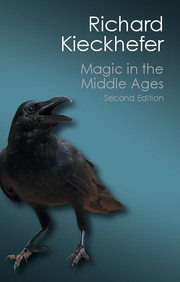Book contents
- Frontmatter
- Contents
- List of illustrations
- Foreword to the Canto edition
- Preface
- 1 INTRODUCTION: MAGIC AS A CROSSROADS
- 2 THE CLASSICAL INHERITANCE
- 3 THE TWILIGHT OF PAGANISM: MAGIC IN NORSE AND IRISH CULTURE
- 4 THE COMMON TRADITION OF MEDIEVAL MAGIC
- 5 THE ROMANCE OF MAGIC IN COURTLY CULTURE
- 6 ARABIC LEARNING AND THE OCCULT SCIENCES
- 7 NECROMANCY IN THE CLERICAL UNDERWORLD
- 8 PROHIBITION, CONDEMNATION, AND PROSECUTION
- Further reading
- Index
1 - INTRODUCTION: MAGIC AS A CROSSROADS
Published online by Cambridge University Press: 05 October 2014
- Frontmatter
- Contents
- List of illustrations
- Foreword to the Canto edition
- Preface
- 1 INTRODUCTION: MAGIC AS A CROSSROADS
- 2 THE CLASSICAL INHERITANCE
- 3 THE TWILIGHT OF PAGANISM: MAGIC IN NORSE AND IRISH CULTURE
- 4 THE COMMON TRADITION OF MEDIEVAL MAGIC
- 5 THE ROMANCE OF MAGIC IN COURTLY CULTURE
- 6 ARABIC LEARNING AND THE OCCULT SCIENCES
- 7 NECROMANCY IN THE CLERICAL UNDERWORLD
- 8 PROHIBITION, CONDEMNATION, AND PROSECUTION
- Further reading
- Index
Summary
This book will approach magic as a kind of crossroads where different pathways in medieval culture converge. First of all it is a point of intersection between religion and science. Demonic magic invokes evil spirits and rests upon a network of religious beliefs and practices, while natural magic exploits “occult” powers within nature and is essentially a branch of medieval science. Yet demonic and natural magic are not always as distinct in fact as they seem in principle. Even when magic is clearly nondemonic it sometimes mingles elements of religion and science: a magical cure, for example, may embody both herbal lore from folk medicine and phrases of prayer from Christian ritual. Secondly, magic is an area where popular culture meets with learned culture. Popular notions of magic got taken up and interpreted by “intellectuals” – a term here used for those with philosophical or theological education – and their ideas about magic, demons, and kindred topics were in turn spread throughout the land by preachers. One of the most important tasks in cultural history is working out these lines of transmission. Thirdly, magic represents a particularly interesting crossroads between fiction and reality. The fictional literature of medieval Europe sometimes reflected the realities of medieval life, sometimes distorted them, sometimes provided escapist release from them, and sometimes held up ideals for reality to imitate.
- Type
- Chapter
- Information
- Magic in the Middle Ages , pp. 1 - 18Publisher: Cambridge University PressPrint publication year: 2014



